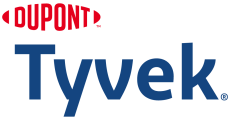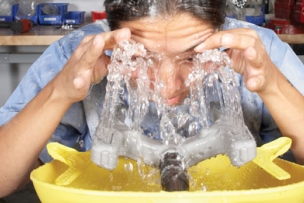WARNINGS: DuPont protective apparel should be worn with appropriate respiratory protection and other PPE necessary to protect against those hazards identified in the hazard assessment. Tyvek®, Tyvek® 400 D, Tyvek® 800 J, ProShield® 10, ProShield® 60 and Tychem® are not flame resistant and should not be used around heat, flame, sparks or potentially flammable or explosive environments. Tyvek® coveralls can be considered for use with the appropriate respirators and other suitable PPE to minimize contact with paint aerosols. Tyvek® garments are not appropriate if they are getting wet (paint is dripping or running, or wet to the touch) or if spotting is observed on skin or garments worn under the coveralls. Tychem® aprons and smocks are available for situations where prolonged liquid exposure may be limited to the front of the torso and/or arms of the wearer. These aprons and smocks can be worn with Tyvek® to provide localized protection while limiting the level of thermal discomfort. Tyvek® 800 J contains natural rubber latex which may cause allergic reactions in some sensitized individuals. Anyone who begins to exhibit an allergic response during the use of DuPont products should immediately cease using these products. The incident should also be reported to DuPont at 1-800-441-3637 so that an investigation can be initiated.
This information is based upon technical data that DuPont believes to be reliable. It is subject to revision as additional knowledge and experience are gained. DuPont makes no guarantee of results and assumes no obligations or liability in connection with this information. It is the user’s responsibility to determine the level of toxicity and the proper personal protective equipment needed. The information set forth herein reflects laboratory performance of fabrics, not complete garments, under controlled conditions. It is intended for information use by persons having technical skill for evaluation under their specific end-use conditions, at their own discretion and risk. Anyone intending to use this information should first verify that the garment selected is suitable for the intended use. In many cases, seams and closures have shorter breakthrough times and higher permeation rates than the fabric. If fabric becomes torn, abraded or punctured, end user should discontinue use of garment to avoid compromising the barrier protection. SINCE CONDITIONS OF USE ARE OUTSIDE OUR CONTROL, WE MAKE NO WARRANTIES, EXPRESSED OR IMPLIED, INCLUDING WITHOUT LIMITATION, NO WARRANTIES OF MERCHANTABILITY OR FITNESS FOR A PARTICULAR USE AND ASSUME NO LIABILITY IN CONNECTION WITH ANY USE OF THIS INFORMATION. This information is not intended as a license to operate under or a recommendation to infringe any patent, trademark or technical information of DuPont or others covering any material or its use.








Talk to Us!
Leave a reply
Your email address will not be published. Required fields are marked *